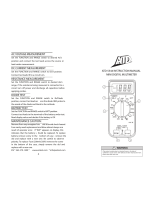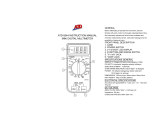Page is loading ...

SAFETY INFORMATION
The following safety information must be observed to
ensure maximum personal safety during the operation of
this meter:
Use the meter only as specified in this manual or the
protection provided by the meter might be impaired.Test
the meter on a known voltage before using it to
determine if hazardous voltages are present.
Do not use the meter if the meter or test leads look
damaged, or if you suspect that the meter is not
operating properly. Never ground yourself when taking
electrical measurements.
Do not touch exposed metal pipes,outlets, fixtures, etc.,
which might be at ground potential. Keep your body
isolated from ground by using dry clothing, rubber shoes,
rubber mats, or any approved insulating material. Turn off
power to the circuit under test before cutting,
unsoldering, or breaking the circuit. Small amounts of
current can be dangerous. Use caution when working
above 60V DC or 30V AC rms. Such voltages pose a
shock hazard.
When using the probes, keep your fingers behind the
finger guards.
Measuring voltage which exceeds the limits of the
multimeter may damage the meter and expose the
operator to a shock hazard. Always observe the meter
voltage limits as stated on the front of the meter.
SPECIFICATIONS
Display: 3½ digit liquid crystal display (LCD) with a
maximum reading of 1999
Polarity: Automatic, positive implied, negative polarity
indication
Overrange: (OL) or (-OL) is displayed
Zero: Automatic
Low battery indication: The " " is displayed when the
battery voltage drops below the operating level
Measurement rate: 2 times per second, nominal
Auto power off: Approx. 10 minutes
Operating environment:
0°C to 50°C at < 70% relative humidity
Storage temperature:
-20°C to 60°C at < 80% relative humidity
Accuracy:
Stated accuracy at 23°C ± 5°C, <75% relative humidity
Temperature Coefficient: 0.1 × (specified accuracy)
per °C. (0°C to 18°C, 28°C to 50°C)
Altitude: 6561.7 Feet (2000m)
Power: 1.5V batteries x2, R03/SIZE AAA
Battery life: 200 hours typical with carbon-zinc
Dimensions: 145mm (H) × 70mm (W) × 34mm (D)
Weight: Approx. 11.1 oz. (315g) including holster
Accessories: One pair test leads, 1.5V battery x2
(installed) and Operating Instructions
DC VOLTS
Ranges: 200mV, 2V, 20V, 200V, 600V
Resolution: 0.1mV
Accuracy: ±(1.0% rdg + 2 dgts)
Input impedance: 200mV: >100MΩ: 2V:10MΩ
20V ~ 600V:9.1MΩ
Overload protection: 600VDC or AC rms
AC VOLTS (50Hz - 500Hz)
Ranges: 200mV, 2V, 20V, 200V, 600V
Resolution: 0.1mV
Accuracy:
±(2.0% rdg + 5 dgts) 50Hz ~ 100Hz on 200mV range
±(2.0% rdg + 5 dgts)
Input impedance: 200mV:>100MΩ: 2V:10MΩ
20V ~ 600V:9.1MΩ
Overload protection: 600V DC or AC rms
CURRENT
Ranges: 10A
Resolution: 0.01A
DC accuracy: ± (3.0% rdg + 3 dgts)
AC accuracy: (50Hz ~ 500Hz) ± (3.5% rdg + 5 dgts)
Voltage burden: 0.2V
Input protection:10A/500V fast blow ceramic fuse
RESISTANCE
Ranges: 200Ω, 2kΩ, 20kΩ, 200kΩ, 2MΩ, 20MΩ
Resolution: 0.1Ω
Accuracy:
±(1.5% rdg + 4 dgts) on 200Ω to 200kΩ ranges
±(2.5% rdg +4 dgts) on 2MΩ range
±(5.0% rdg + 5 dgts) on 20MΩ range
Open circuit volts: -0.45Vdc (-1.2Vdc on 200Ω range)
Overload protection: 500V DC or AC rms
DIODE TEST
Test current: 1.0mA (approximate)
Accuracy: ±(3.0% rdg + 3 dgts)
Resolution: 10mV
Audible indication: <0.25V
Open circuit volts: 3.0Vdc typical
Overload protection: 500VDC or AC rms
CONTINUITY
Audible indication: Less than 25Ω
Response time: 500ms
Overload protection: 500VDC or AC rms
MM39 MULTIMETER
INSTRUCTION
MANUAL
MARTINDALE
ELECTRIC
Trusted by professionals
MM39 instruct rev1:Layout 3 02/03/2009 12:26 Page 1

OPERATION
Before taking any measurements, read the Safety
Information Section. Always examine the instrument for
damage, contamination (excessive dirt, grease, etc.) and
defects. Examine the test leads for cracked or frayed
insulation. If any abnormal conditions exist do not
attempt to make any measurements.
Data Hold
Press [HOLD] button to lock the reading on display, and
release it by pressing the button again.
Manually Selecting Range
The meter also has a manual range mode. In manual
range, you select and lock the meter in a range. To
manually select a range:
Press [RANGE] button to hold the selected range.
Subsequently pressing the [RANGE] button will select
each range in sequence from the lowest to highest
range. Hold the button for 2 seconds to return to the
Autorange Mode.
Voltage Measurements
1. Connect the red test lead to the "VΩ" jack and the
black test lead to the "COM" jack.
2. Set the Function/Range switch to the desired Voltage
type (AC or DC) and range. If magnitude of voltage is
not known, set switch to the highest range and reduce
until a satisfactory reading is obtained.
3. Connect the test leads to the device or circuit being
measured.
4. For DC, a (-) sign is displayed for negative
polarity, positive polarity is implied.
Current Measurements
1. Connect the red test lead to the (10A) jack and the
black test lead to the "COM" jack.
2. Set the Function/Range switch to the DC or AC
ranges.
3. Remove power from the circuit under test and open
the circuit path where the measurement is to be taken.
Connect the meter in series with the circuit.
4. Apply power and read the value from the display.
Resistance Measurements
1. Set the Function/Range switch to the desired
resistance range.
2. Remove power from the equipment under test.
3. Connect the red test lead to the "VΩ" jack and the
black test lead to the "COM" jack.
4. Connect the test leads to the points of measurements
and read the value from the display.
Diode Tests
1. Connect the red test lead to the "V" jack and the black
test lead to the "COM" jack.
2. Set the Function/Range switch to the " " position.
3. Turn off power to the circuit under test. External
voltage across the components causes invalid
readings.
4. Touch probes to the diode. The forward-voltage drop
is about 0.6V (typical for a silicon diode).
5. Reverse probes. If the diode is good, "OL" is
displayed. If the diode is shorted, "0.00" or
another number is displayed.
6. If the diode is open, "OL" is displayed in both
directions.
7. Audible Indication: Less than 0.25V.
Continuity Measurements
1. Set the Funtion switch to the position.
2. Turn off power to the circuit under test. External
voltage across the components causes invalid
reading.
3. Connect the test leads to the two points at which
continuity is to be tested. The buzzer will sound if the
resistance is less than approximately 25Ω.
Auto Power off
1. Auto power off: approx. 10 minutes.
2. After auto power off, press any button to restart
the meter, and the reading will be maintained in the
display.
Cancellation of Auto Power Off Feature:
Press and hold the (RANGE) button while rotating
function switch from off to any position. The auto power
off feature is disabled. Note “APO” annunciator is missing
from the LCD.
MAINTENANCE
Battery Replacement
Power is supplied by a 1.5 volt battery x2 (R03/SIZE
AAA). The " " appears on the LCD display when
replacement is needed. To replace the battery, remove
the 2 screws from the back of the meter and lift off the
battery cover. Insert new batteries, observing correct
polarity.
WARNING
Remove test leads before changing battery,
fuse or performing any servicing.
Fuse Replacement
If no current measurements are possible, check for a
blown overload protection fuse. For access to fuses,
remove the four screws from the back of the meter and lift
off the front case. Replace F1 only with the original type
10A/500V, fast acting ceramic fuse.
Cleaning
Wipe the case with a damp cloth and mild detergent. Do
not use abrasives or solvents. Dirt or moisture in the
terminals can affect readings.
Safety: Conforms to IEC61010-1 (EN61010-1),CATIII
600V, Class II, Pollution degree 2 Indoor use.CAT III: is for
measurements performed in the building installation.
EMC: Conforms to EN61326.
The symbols used on this instrument are:
Equipment complies with relevant EU Directives
AC (Alternating Current)
Ground
Direct Current
Equipment protected by Double Insulation (Class II)
Caution - refer to accompanying documents
Caution - risk of electric shock
End of life disposal of this equipment should
be in accordance with relevant EU Directives
MM39 instruct rev1:Layout 3 02/03/2009 12:26 Page 2
/


